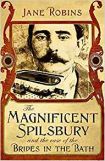The Magnificent Spilsbury and the Case of the Brides in the Bath by Jane Robins
During the early months of 1915, Britain was fighting for her life during the First World War, and newspaper headlines were preoccupied with the army's exploits and outrages by the enemy. For a time, only one event at home could compete with them on the front news pages – the unhappy fate of two or three brides who had been drowned, in separate incidents, in their baths, and the fact that one man was probably responsible.
| The Magnificent Spilsbury and the Case of the Brides in the Bath by Jane Robins | |
|
| |
| Category: Crime | |
| Reviewer: John Van der Kiste | |
| Summary: A combined study of the true-life crimes of serial murderer George Joseph Smith, and of Bernard Spilsbury, the rising pathologist whose evidence helped to convict him. | |
| Buy? Yes | Borrow? Yes |
| Pages: 304 | Date: April 2010 |
| Publisher: John Muray | |
| ISBN: 978-1848541078 | |
|
| |
The story begins with the tale of Bessie Mundy, who feared she was destined to live and die an old maid when she had the apparent good fortune to meet a Henry Williams in 1910. After a whirlwind courtship, they married, and two years later she was found dead in her bath in their lodgings. Only a few weeks later George Smith met Alice Burnham, another woman who had reached her thirties without showing any signs of getting married. They tied the knot, and she died in similar circumstances on their honeymoon in a guest house. In 1914 John Lloyd married Margaret Lofty, who was also virtually resigned to being left on the shelf. She met a similar fate.
When these deaths were reported in the papers, Alice Burnham's father (who had taken an instant dislike to his son-in-law) and one of the landlords of the guest houses involved noticed the similarities in all three cases. They thought it was too much of a coincidence, and advised the police to investigate. The inspector who arrested 'Mr Lloyd' was soon able to confirm that his man and Mr Smith were one and the same – and, later, that he was also Henry Williams. It was then revealed that he had contracted seven marriages under three aliases as well as his own name, and three of his brides had died while taking a bath. By the time the police had prepared their evidence, there were 121 witnesses ready to be called by the prosecution.
In accordance with English law, Smith could only be put on trial for one murder, namely that of 'Bessie Williams', his first victim. Nevertheless, the prosecution used the deaths of the other two women to establish the pattern of his crimes. The case coincided with the rise of Bernard Spilsbury, a young forensic pathologist whose role in helping to bring Dr Crippen to the gallows after being found guilty of poisoning his wife in 1910 had made him almost a household name. Despite angrily protesting his innocence to the last, Smith was found guilty and executed in August 1915.
The author has marshalled the facts of this horrific story very well and has presented it almost with the tension of a gripping novel. We are introduced first to the three tragic victims and their families before Spilsbury makes his entrance and we learn of Smith's earlier marriages. His first wife, Caroline Thornhill (who was, in fact, his only legal wife – all the others were bigamous), whom he married under the assumed name of Oliver Love, fled to Canada after he had forced her to find work as a maid and to steal from her employers, a crime which led to her spending twelve months in prison before she incriminated him and he was sent down for twice as long. There were three other wives, one of whom, Edith Pegler, he married after she answered his advertisement for a housekeeper in Bristol and whom he would leave for months at a time, saying he needed to travel to buy and sell antiques as a cover for yet more marriages.
The chilling saga is set skilfully against the background of Edwardian England, where a woman counted for little if anything if she was still a spinster by the age of thirty, and the first months of war. Occasionally the author's eye for detail strays a little too far into other fields. For example, her description of the terror that the Zeppelin brought to English skies in 1915, fascinating as it is, is not strictly relevant and could have been shortened. Yet that only detracts to a minor degree from the compulsively readable saga of Smith, his unfortunate seven wives, and the pathologist who helped the forces of law and order to bring him to justice. Indeed, as a result of the trial, Spilsbury became something of a 'star performer', and the last chapter follows his remaining thirty-year career before ill-health and failing powers sadly led to him taking his own life.
For further reading, you might enjoy two other true crime titles, The Suspicions of Mr Whicher by Kate Summerscale, and Edwardian Murder: Ightham & the Morpeth Train Robbery by Diane Janes. We also liked White Bodies by Jane Robins.
Please share on: ![]() Facebook,
Facebook, ![]() Twitter and
Twitter and
![]() Instagram
Instagram
![]() You can read more book reviews or buy The Magnificent Spilsbury and the Case of the Brides in the Bath by Jane Robins at Amazon.co.uk Amazon currently charges £2.99 for standard delivery for orders under £20, over which delivery is free.
You can read more book reviews or buy The Magnificent Spilsbury and the Case of the Brides in the Bath by Jane Robins at Amazon.co.uk Amazon currently charges £2.99 for standard delivery for orders under £20, over which delivery is free.
![]() You can read more book reviews or buy The Magnificent Spilsbury and the Case of the Brides in the Bath by Jane Robins at Amazon.com.
You can read more book reviews or buy The Magnificent Spilsbury and the Case of the Brides in the Bath by Jane Robins at Amazon.com.
Comments
Like to comment on this review?
Just send us an email and we'll put the best up on the site.

